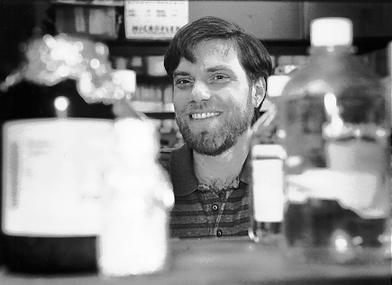
Eugene M. Oltz, Ph.D., is investigating the immune system's pathogen recognition process.
Researcher seeks insight into how immune system identifies pathogens
It has long been a mystery to immunologists how the human body's immune system identifies and confronts the numerous pathogens it faces.
This daunting task is further complicated by the ability of many pathogens, such as bacteria and viruses, to rapidly evolve new ways of hiding from our immune cells.
"For many years immunologists struggled with the idea that the immune system could adapt to changing pathogens and recognize nearly anything that nature throws our way," said Eugene M. Oltz, Ph.D., assistant professor of Microbiology and Immunology.
Insight into this pathogen recognition process is critical to providing new knowledge regarding lymphocyte development, Oltz said.
The duty of pathogen recognition falls primarily upon specialized immune cells, called B- and T-lymphocytes. It is estimated that in a healthy individual approximately one billion of these cells are in circulation, and each of them may display different pathogen-binding proteins, called antibodies or T-cell receptors.
For many years this enormous diversity of pathogen receptors was difficult to explain since, until the mid-1970's, scientists believed that each protein expressed by a cell was the product of a distinct gene. If this model were true for antibody and T-cell receptor production, it would mean that more than half our genome would be devoted to the production of immune receptors, an unlikely scenario to say the least.
It was therefore satisfying to immunologists when it was discovered that, unlike all other genes, genes that encode for antibodies and T-cell receptors are not inherited in a functional form.
Instead, the human body is provided with a large number of gene pieces which can be put together in nearly any combination. This process, called VDJ recombination, occurs early in the development of a lymphocyte, via a unique cutting and pasting of DNA.
It is akin to each B-cell shuffling a large deck of cards and then drawing three of these cards at random. VDJ recombination has evolved in animals with highly developed immune systems, allowing lymphocytes to produce a nearly limitless repertoire of receptor proteins that can take on almost any pathogen.
People whose genes cannot perform VDJ recombination due to genetic defects lack both B- and T-cells suffer from a condition called severe-combined immunodeficiency.
Although VDJ recombination provides immune cells with an essential level of diversity, the process has its drawbacks as well. At some low level, these gene shuffling events can be misdirected, resulting in chromosomal abnormalities that lead to a wide variety of lymphoid tumors such as leukemias and lymphomas.
Proper targeting of recombination is not only important for avoiding tumors, but also for guiding B- and T-lymphocytes through their development. For example, only B-cells should assemble their antibody genes and only T-cells should rearrange their T-cell receptor genes.
"What the people in my lab are interested in is how these closely related recombination events are targeted to the appropriate areas in the genome, allowing each type of lymphocyte to develop normally," said Oltz.
The data gathered in Oltz's lab has revealed that DNA elements which were thought to be involved only in gene expression are also important for directing VDJ recombination. One of these elements binds to a molecule called NF-kB, which had been implicated in the regulation of immune response.
In recent work Oltz's lab has developed cell lines deficient for NF-kB and has found that these cells are defective for recombination at a specific type of antibody gene. These findings will appear in the December issue of Immunity.
Oltz's research is funded by a grant from the National Institutes for Health, an NIH Career Development Award, and the Vanderbilt University School of Medicine's Vice-Chancellor's Scholar Award.













